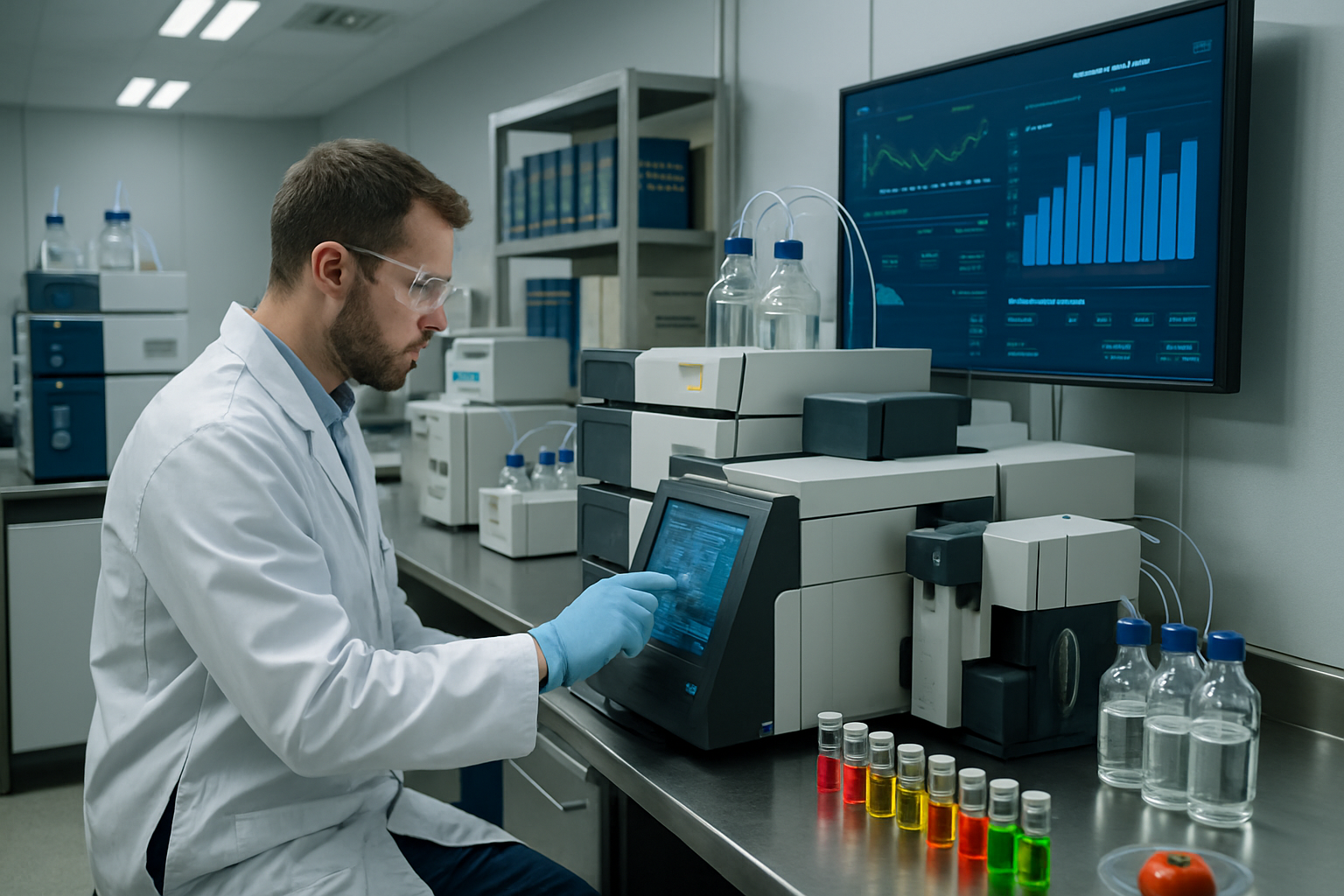Why Pesticide Residue Monitoring is Critical in the U.S. and Canada
Pesticides remain essential in modern agriculture, protecting crops from pathogens, insects, and weeds. Nevertheless, residual traces of organophosphates, carbamates, pyrethroids, and neonicotinoids may persist in consumable commodities. When concentrations exceed regulatory thresholds, these residues can present toxicological hazards, including neurotoxicity, endocrine disruption, and cumulative dietary risks.
In the United States, the Environmental Protection Agency (EPA) defines Maximum Residue Limits (MRLs) through comprehensive toxicological evaluation and exposure modelling. Surveillance is operationalized through the U.S. Department of Agriculture (USDA) Pesticide Data Program (PDP), a nationally representative survey that quantifies residues across diverse commodities and distribution channels (USDA, 2024).
In Canada, the Canadian Food Inspection Agency (CFIA) and Pest Management Regulatory Agency (PMRA) govern pesticide tolerance levels and enforce residue standards based on risk assessments (CFIA, 2023). These agencies align with international Codex standards to maintain trade compliance while safeguarding consumer health.
Within this regulatory context, Mérieux NutriSciences provides food manufacturers and processors across North America with scientifically rigorous pesticide residue testing that aligns with regional and global compliance requirements.
Mass Spectrometry: The Industry Standard for Pesticide Residue Analysis
The chemical diversity and low concentration of pesticide residues demand analytical methods with exceptional sensitivity, specificity, and accuracy. Mass spectrometry (MS), in combination with chromatographic separation, has become the industry standard for detecting and quantifying pesticide residues in complex food matrices.
LC–MS/MS for Polar and Thermolabile Pesticide Detection
Liquid chromatography–tandem mass spectrometry (LC–MS/MS) is indispensable for polar or thermally labile pesticides. High-pressure liquid-phase separation is followed by tandem mass fragmentation, enabling multi-residue quantitation at part-per-billion (ppb) levels.
According to the U.S. Food and Drug Administration (FDA), LC–MS/MS underpins the official Pesticide Analytical Manual (PAM I) and is integral to regulatory multi-residue monitoring (FDA, 2024). Chromatographic separation, combined with highly specific mass-selective detection, ensures precise quantitation across diverse commodities, from leafy greens and grains to processed foods.
Mérieux NutriSciences deploys advanced LC–MS/MS instrumentation throughout its North American laboratories, ensuring reproducible, traceable, and regulatory-compliant results.
GC–MS/MS for Volatile and Semi-Volatile Pesticides
Gas chromatography–tandem mass spectrometry (GC–MS/MS) is used for volatile and semi-volatile pesticides such as organochlorines and pyrethroids. High-temperature vapor-phase separation, coupled with triple-quadrupole detection, provides robust chromatographic resolution and confirmatory ion identification.
The integration of LC–MS/MS and GC–MS/MS workflows allows Mérieux NutriSciences to achieve comprehensive coverage across the pesticide spectrum, supporting both multi-residue screenings and targeted confirmatory analyses.
Emerging Trends in Pesticide Residue Testing Across North America
Residue testing in North America continues to evolve rapidly. Key technological and methodological advancements include:
- Multi-Residue Methodologies (MRMs): Single-run assays now detect hundreds of pesticides simultaneously, reducing analytical time and matrix interferences (FDA, 2024).
- High-Resolution Mass Spectrometry (HRMS): Time-of-flight and Orbitrap systems enable high-accuracy mass detection, retrospective analysis, and identification of emerging or unregistered compounds.
- Automated Sample Preparation Systems: Robotic extraction, cleanup, and derivatization enhance reproducibility and throughput while minimizing human error.
- Regulatory Harmonization: U.S. EPA and Canadian PMRA alignment of MRLs facilitates cross-border compliance for multinational food producers.
Mérieux NutriSciences continuously incorporates these innovations into its workflows to maintain regulatory relevance, analytical robustness, and operational efficiency.
Technical Challenges in Pesticide Residue Analysis
Several factors complicate pesticide residue testing:
- Matrix Interference: Lipids, pigments, and polyphenols can suppress or enhance ionization, requiring matrix-optimized calibration and sample cleanup.
- Novel Pesticide Chemistry: Continuous introduction of new actives demands ongoing method validation to maintain comprehensive analytical coverage.
- Regulatory Divergence: Differences between U.S. and Canadian MRLs, coupled with international Codex limits, necessitate adaptive compliance strategies.
Mérieux NutriSciences applies validated multi-residue extraction protocols, matrix-optimized calibration models, and advanced data interpretation algorithms to address these challenges. Its scientific and regulatory specialists collaborate with food manufacturers to interpret residue profiles, conduct risk assessments, and ensure domestic and export standards compliance.
Mérieux NutriSciences’ Analytical Framework for North American Food Testing
Multi-Residue Surveillance Programs
LC–MS/MS and GC–MS/MS instrumentation enable the simultaneous detection of hundreds of pesticide compounds, ensuring compliance with USDA PDP and CFIA National Chemical Residue Monitoring Programs (USDA, 2024; CFIA, 2023).
Targeted Single-Residue Analyses
Certain products, such as honey, herbal teas, or high-value botanicals, require high-specificity assays for individual compounds (e.g., glyphosate, ethylene oxide). Tailored chromatographic gradients and confirmatory ion transitions ensure precise quantitation.
Risk-Based and Compliance-Oriented Testing
Beyond generating analytical data, Mérieux NutriSciences partners with clients to develop risk-based monitoring strategies that incorporate supplier risk assessment, import/export compliance, and tolerance verification aligned with EPA, USDA, CFIA, and PMRA standards.
The Future of Pesticide Residue Surveillance in North America
Emerging trends will define the next generation of residue testing:
- Portable Field-Deployable MS: Near-real-time residue screening at harvest or import points.
- Machine Learning Integration: Enhanced peak identification and detection of unknown compounds.
- Sustainable Analytical Practices: Reduced solvent and energy usage aligns with green chemistry principles.
Mérieux NutriSciences is actively investing in these innovations, solidifying its leadership in North American food safety analytics.
Ensuring Analytical Confidence and Food Safety Compliance
Mass spectrometry has transformed pesticide residue testing, offering unmatched precision and confidence in food safety verification. LC–MS/MS and GC–MS/MS remain essential for compliance, consumer protection, and supply chain integrity.
Through state-of-the-art instrumentation, validated analytical protocols, and regulatory expertise, Mérieux NutriSciences’ Chemistry and Pesticide testing services empower North American food manufacturers and processors to meet the highest analytical and compliance standards, ensuring the safety and reliability of food products.
References
Canadian Food Inspection Agency. (2023). National chemical residue monitoring program – Annual report 2023. https://inspection.canada.ca/en/food-safety-for-industry/chemical-residues-microbiology/chemical-residues/national-chemical-residue-monitoring-program
U.S. Department of Agriculture. (2024). Pesticide data program – Annual summary, calendar year 2023. https://www.ams.usda.gov/sites/default/files/media/2023PDPAnnualSummary.pdf
U.S. Food and Drug Administration. (2024). Pesticides – Food & chemical contaminants. https://www.fda.gov/food/chemical-contaminants-pesticides/pesticides
